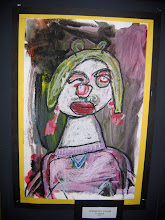“Welcome all to NAEA's virtual home! This dynamic community of practice is where visual arts teachers, scholars, researchers and professors, students, administrators, and art museum educators, and artists come together around a shared belief in the power of the arts in developing human potential.” (naea, 2009)
http://www.naea-reston.org/olc/pub/NAEA/home/
“The Communities of Practice program provides ongoing professional development opportunities for teaching artists who work with students with disabilities. VSA arts has developed this professional learning community by drawing from the fields of teacher professional development, evaluation-research, and business management.
The core purpose of this VSA arts program is to cultivate meaningful professional discussion about student learning, universally designed curriculum, differentiated instruction, and assessment for students with disabilities. This discussion is grounded in reviews of curriculum documents and student learning evidence in relation to learning outcomes.
In the Communities of Practice, participants generate, evaluate, and share valuable curriculum knowledge with their colleagues. Expert instructional coaches and participants exchange feedback on their curriculum, assessment tools, and student work samples using a range of online and tele-conferencing tools. The Communities of Practice is meant to be an enhancement of existing professional development for teaching artists in the VSA arts U.S. domestic affiliate network. This year (fall 2008-spring 2009), teams from our Teaching Artist Fellowships and affiliates in Florida, Massachusetts, Mississippi, and Texas participated.” (vsa arts, 2009)
http://www.vsarts.org/x2252.xml
I am involved with both of these communities of practice, yet a once a year community event is not enough for me. I wish I had a community of practice within my school district or even better my school buildings.
Being an art teacher I am estranged from the art educational world because I am the only art teacher in the building. I am slightly involved with the educational community of practice; yet our tasks are different enough to cause the connection to be lacking. Therefore the sense of community for myself within the school building is poor.
Within the school district I also feel the community of practice is lacking; even considering there are 10 art teachers in the system. We meet a couple of times a year. Put on a district wide art show. Go to a free conference together and continue on with our separate lives.
Reading:
“Communities of Practice Learning as a Social System” by Etienne Wenger [Published in the "Systems Thinker," June 1998]
http://www.co-i-l.com/coil/knowledge-garden/cop/lss.shtml
Impressed upon me that the art community of practice within my school district is important, and it is my responsibility to start that community by reaching out to my fellow art teachers and forming relationships with bonds of like practice. Where do I begin? How do I approach my colleges?
“Seven principles for cultivating communities of practice
In Silicon Valley, a community of circuit designers meets for a lively debate about the merits of two different designs developed by one of the participants. Huddling together over the circuit diagrams, they analyze possible faults, discuss issues of efficiency, propose alternatives, tease out each other's assumptions, and make the case for their view. In Boston, a group of social workers who staff a help line meet to discuss knotty client problems, express sympathy as they discuss difficulties, probe to understand each other's feelings, and gently offer suggestions. Their meetings are often deeply challenging and sometimes highly emotional. The fact-driven, sometimes argumentative, meetings of the Silicon Valley circuit designers are extremely different from the compassionate meetings of the social workers in Boston. But despite their differences, the circuit designers' and social workers' communities are both vibrant and full of life. Their energy is palpable to both the regular participants and visitors.
Because communities of practice are voluntary, what makes them successful over time is their ability to generate enough excitement, relevance, and value to attract and engage members. Although many factors, such as management support or an urgent problem, can inspire a community, nothing can substitute for this sense of aliveness.
From our experience we have derived seven principles:
1. Design for evolution.
2. Open a dialogue between inside and outside perspectives.
3. Invite different levels of participation.
4. Develop both public and private community spaces.
5. Focus on value.
6. Combine familiarity and excitement.
7. Create a rhythm for the community.
These design principles are not recipes, but rather embody our understanding of how elements of design work together. They reveal the thinking behind a design. Making design principles explicit makes it possible to be more flexible and improvisational.” (Wenger, 2002)
Cultivating Communities of Practice: A Guide to Managing Knowledge - Seven Principles for Cultivating Communities of Practice (2002.3.25)
by Etienne Wenger, Richard McDermott, and William M. Snyder
http://hbswk.hbs.edu/archive/2855.html
The full rendition of this article really lays out the focus points of starting a voluntary group. Why are these professional individuals going to give up their free time to meet with like minds? They aren’t unless they see that the meeting will help them within their profession, they find the topics of the meeting interesting and compelling, and novelty is constantly engaging them.
This sounds like a lot of work. Yes, but the rewards will be reaped within my classroom☺. It’s worth the effort for my students and me.
Monday, September 21, 2009
Subscribe to:
Post Comments (Atom)

No comments:
Post a Comment